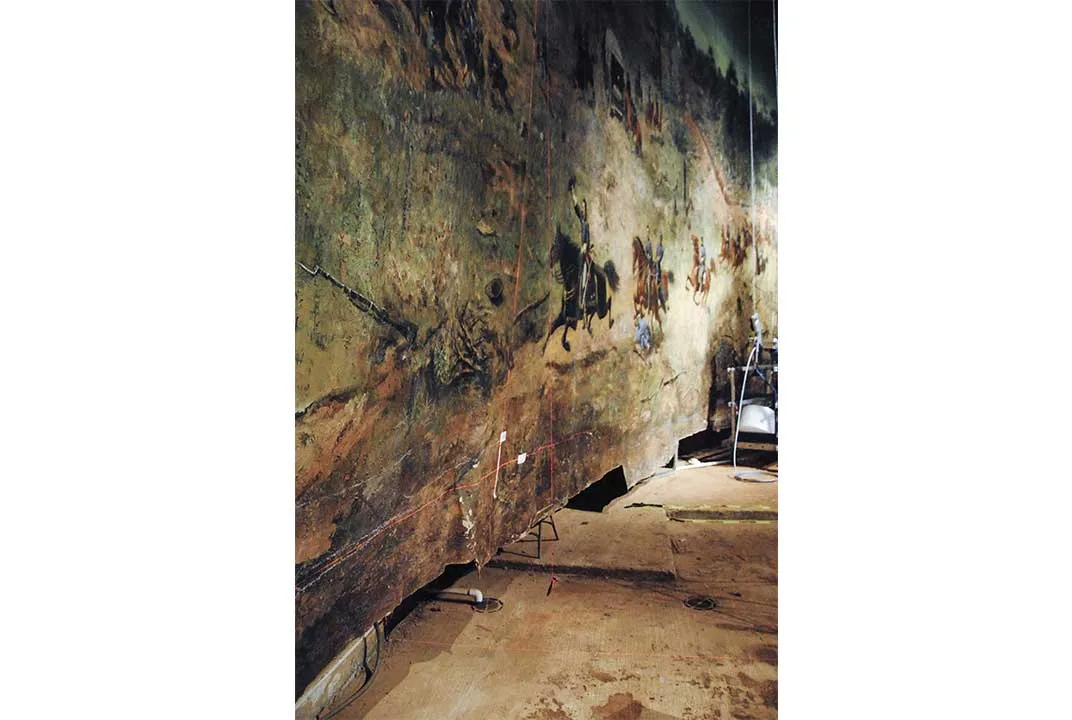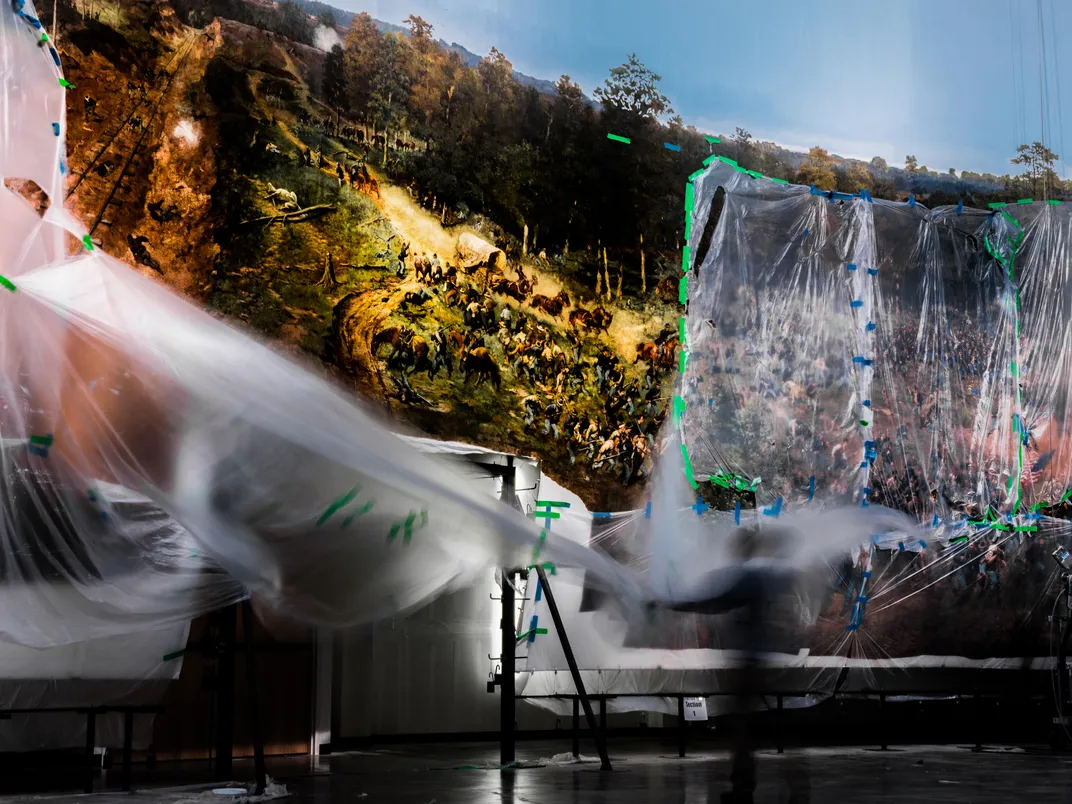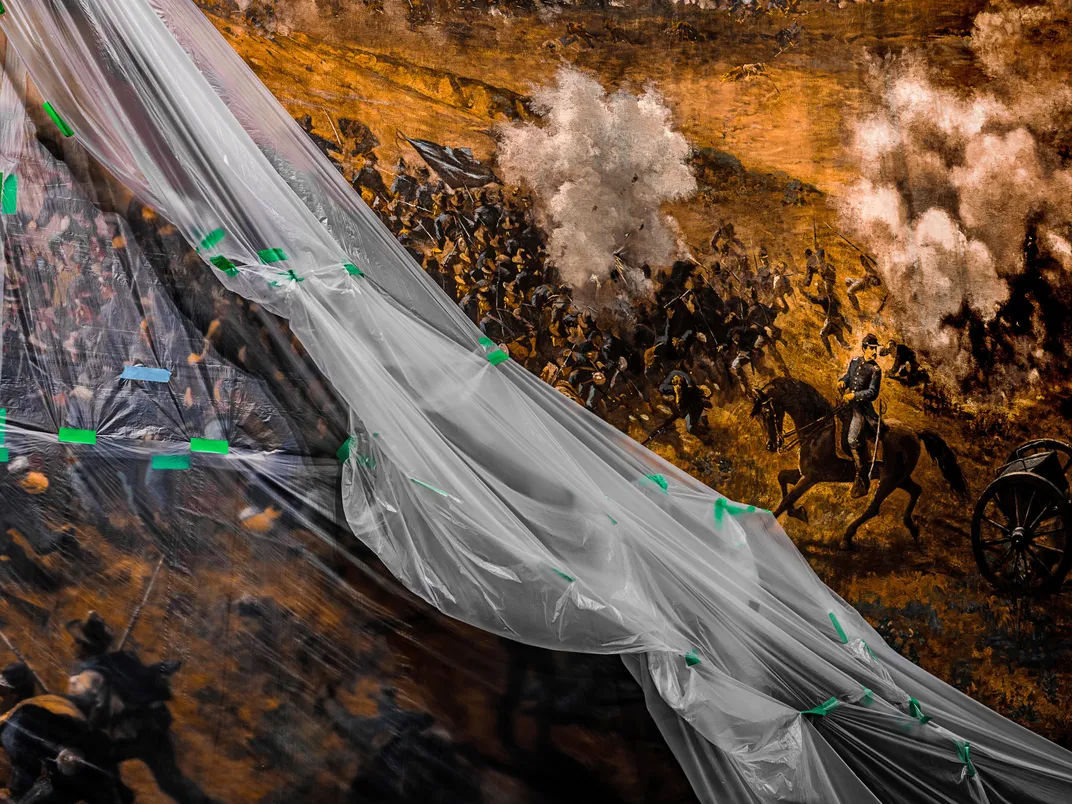When I was a little boy growing up in South Carolina, my mom decided to take me and a neighborhood girl on a big history trip and visit the sights in Atlanta. Emphasis on the big. We saw Stone Mountain, the half-finished Confederate rival of Mount Rushmore. And at some point I recall clicking through the turnstile of a massive building at the Atlanta Zoo to see something amazing, “the largest painting in the world.
I wish I could remember anything other than that everything felt dank in there, like a long unvisited cellar, but the thing was, as promised, insanely big. It was called the Cyclorama, and the canvas was suspended around the 360 degrees of a high circular wall, showing hundreds of clashing soldiers. If I had listened to the guide, I might have heard that here was a great Confederate victory in the Civil War, depicted in images almost three stories high and more than a football field long. And I would have learned of its mysterious origin—how in the 1890s, a circus came to town with this spectacular visual entertainment and some exotic animals. But the circus went bankrupt, and everything that I was looking at—this big canvas and all the animals—had washed up here, in Atlanta’s Grant Park.
All of that is an exaggeration, of course. It’s not the largest painting in the world, although it’s up there; and while it’s huge, those dimensions are mostly hyped. The painting depicts the Battle of Atlanta, a decisive Union victory in 1864. And the story of the Cyclorama’s journey is no carnival tale but more a Homeric odyssey for a canvas that got touched up and repainted as it got kicked farther and farther south until it was marooned in the Atlanta Zoo.
To gaze upon the painting today—restored, reinstalled and reopening in February at the Atlanta History Center—is to see an unintended monument to the wonderments of accretion: accretions not merely of paint, but of mythmaking, distortion, error, misinterpretation, politics, opportunism, crowd-pleasing, revisionism, marketing, propaganda and cover-up (literally). Only a few years ago, the attraction seemed done for. Attendance was down to stragglers, and the city was hemorrhaging money. The future of the big canvas seemed to be a storage bin somewhere and, after some time, the dustbin.
But then a few folks in Atlanta realized that restoring the painting would not only resurrect one of the more curious visual illusions of the 1880s, but also show, in the paint in front of your eyes, a neat timeline of the many shifts in Southern history since Appomattox. This was no mere cyclorama. What the saviors had on their hands was, ladies and gentlemen, the largest palimpsest of Civil War memory to be found anywhere on planet Earth—the Atlanta Cyclorama, one of the great wonders of the postmodern world.

Cycloramas were a big popular entertainment once upon a time, and the way it worked was this: Once you entered the big building you would typically proceed to a staircase that you walked up, to a platform located in the dead center of a painting, completely encircling you. The canvas was slightly bowed away from the wall, and the horizon line of the painting’s action was at the viewer’s eye level. As much as a third of the top of the painting was sky painted increasingly dark to the top to create a sense of distance extending away. And the bottom of the canvas would often be packed up against a flooring of dirt with real bushes and maybe guns or campsites, all part of a ground-floor diorama that, in the limited lighting, caused the imagery in the painting to pop in the viewer’s mind as a kind of all-enveloping 3-D sensation.
“It was the virtual reality of its day,” Gordon Jones, the curator at the Atlanta History Center, told me. The effect was like walking inside one of those stereoscopes, the early View-Masters of that time, that tricked the eye into perceiving space and distance. Standing on that platform was like sinking into this slight illusionary sense—in this case, that you were a commander on a hill taking in the battle at hand.
Beginning in the 1880s, these completely circular paintings started appearing from half a dozen companies, such as the American Panorama Company in Milwaukee, where Atlanta’s canvas was conceived. APC employed more than a dozen German painters, led by a Leipzig native named Friedrich Heine. Cycloramas could depict any great moment in history, but, for a few years in the 1880s, the timing was just right for Civil War battle scenes. A single generation had passed since the end of the Civil War and survivors everywhere were beginning to ask the older family members, what happened in the war?
These giant paintings constituted the first time anyone in America encountered a sensation far more immersive than a magazine illustration or a Mathew Brady photograph—the illusion of seeing a full reality, the grand overview, viewed from on high—the big picture.
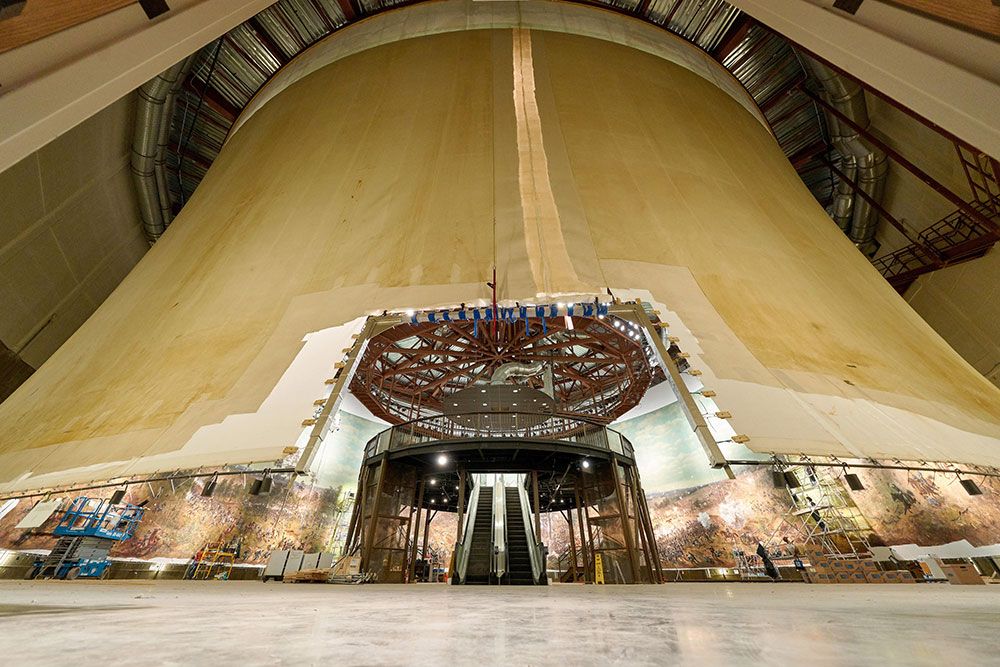
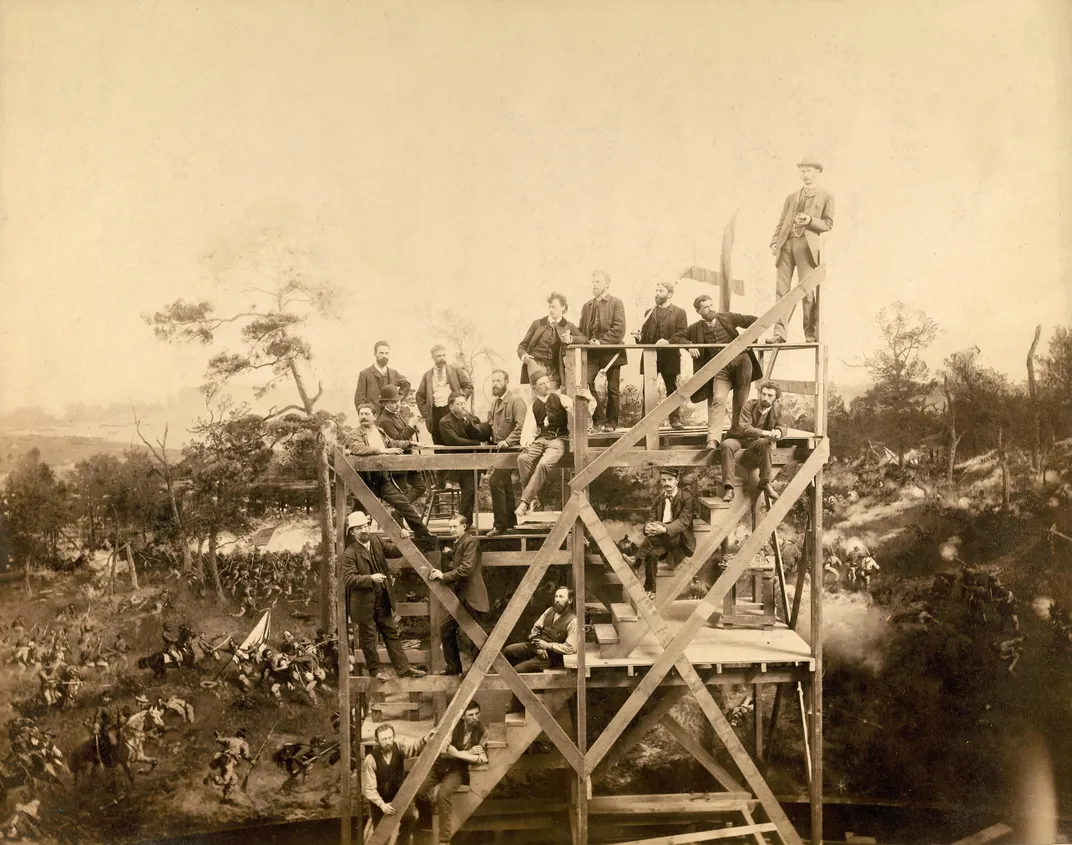
In the heyday of this new medium, one might gain admission to see the Battle of Gettysburg, the Storming of Missionary Ridge and the Battle Above the Clouds, or the Merrimac and Monitor Naval Battle. For a change of pace, maybe you’d catch Custer’s Last Stand, the Great Chicago Fire or Christ’s Triumphal Entrance to Jerusalem.
The Battle of Atlanta Cyclorama was significant because it captured this one moment of the Civil War when everything changed. That midsummer of the war’s fourth year, Northern voters were losing interest, Lincoln’s popularity was sinking, an election was coming up and all news from the battlefields had been bad. Then, in an instant, momentum turned around. Atlanta was defeated, and afterward, Gen. William Tecumseh Sherman turned east for the long march that ended the war.
But this battle almost went the other way, especially at one key moment—4:45 p.m. on July 22, 1864. On the railroad line just outside Atlanta, near a place called the Troup Hurt House, the Union Army had set up a trench line with artillery commanded by Capt. Francis DeGress. Rebels broke that line and were heading to take on the Yankee troops until Gen. John “Black Jack” Logan counterattacked and pushed the Confederates back.
“If you are going to have a battle scene, you don’t paint a walkover, right?” explained Jones. “You don’t make it a 42-0 rout. There’s no glory in that. There’s glory when you win by a point with a field goal in the last second of overtime. So, this is that moment.”
The Battle of Atlanta Cyclorama opened in Minneapolis, to a Northern audience in the summer of 1886. A few weeks later, a local newspaper reported that General Sherman declared it to be “the best picture of a battle on exhibition in this country.” Part of its allure was not just the cognitive effect of a 3-D sensation, but also the accuracy of detail. The Milwaukee Germans interviewed lots of Union veterans, they traveled to Atlanta to sketch locations and they spoke to Confederates. In the studio, helping out, was Theodore Davis, war illustrator for Harper’s Weekly, who was on the field that July 22. (The Germans thanked Davis by painting him on horseback just behind a covered-wagon ambulance.)
The pinpoint accuracies on the canvas were impressive—the weaponry on the field, the uniforms by rank and even details down to the sleigh-like cut of an artillery driver’s saddle. For the vets, there were specific commanders visible among the vast battle confusion, recognizable on the canvas. Gen. James Morgan, Gen. Joseph Lightburn and Gen. James McPherson, lying in the covered-wagon ambulance, where he would die of his wounds.
General Sherman can be spotted on a far hill, overseeing the maneuvers, but the biggest, most recognizable figure is Gen. Black Jack Logan. The painters of the day made him huge because they knew who they were painting for, which is also why there are no recognizable Confederates in the painting. But in Minnesota, where the tour of the painting began, they knew Logan would draw the crowds. “He had star power,” Jones said. As a postwar civilian, Logan would become even more prominent, eventually picked by James Blaine in 1884 as his vice presidential nominee. But most important, in the North, soldiers loved him. “They knew Logan,” Jones said. “He was right up there. If he’s not Jesus or Moses, he’s Abraham.”
The Cyclorama was a big moneymaker. Crowds packed the rotundas to see a battle, and veterans were full of pride to point out to family members “where I was.”
Politicians spotted a media opportunity. The Republican nominee in 1888 was Indiana’s Benjamin Harrison, and although he had not fought in the Battle of Atlanta, he had been a few miles away a few days before. So, as the painting was prepped to travel to Indianapolis, some bright Harrison campaign operative convinced the manager of the Cyclorama to paint over the figure of Harper’s Weekly illustrator Theodore Davis on the battlefield, and make him into Gen. Benjamin Harrison.
Soon enough, the Indiana papers encouraged customers to see the new Cyclorama, which suddenly appeared to have a new name. “HARRISON AT ATLANTA,” the ads screamed. Harrison lost the popular vote that November, but in the electoral college, he won—thanks in part to the votes in Indiana and neighboring states.
When the Harrison touch-up was exposed in the press, the revelation was an embarrassment for everyone. Stolen valor was a thing then, too. But it was the Cyclorama manager who suffered most. He resigned in disgrace, while Harrison would stay mounted upon that horse for more than a century. Jones recently put Theodore Davis back in his saddle, his rightful place documented in very early photos of the original image. “The hierarchy of our thinking,” Jones said, “is to restore the illusion intended by the artist.” But throughout the canvas, Jones added, there are “exceptions, too”—changes that tell other stories, and they will stay.
No one thinks of the late 19th century as a frantic time of new media, but by 1890, magic lantern shows were popular and the big leap in virtual reality, movies, was only a few years off. So after only a couple of years of popularity, the easy money in cycloramas had been made; time for the smart investors to sell off while the getting’s good. The Battle of Atlanta went on the block that year and sold to a Georgian named Paul Atkinson. He was a semi-successful barker, a poor man’s P.T. Barnum.
The youngest brother of four Confederate soldiers, Atkinson was known for managing the career of his wife, Lulu Hurst. She performed alleged feats of strength onstage, claiming that she gained her superpowers after a mysterious encounter with an electrical storm—performing under names like “The Magnetical Electrical Georgia Girl” and “The Amazing Wonder of the Nineteenth Century.”
As Atkinson prepared the painting for its next move—to Chattanooga, in 1891—he saw that there was something sublimely marketable in the moment the Germans chose to paint. The Southern surge, and the Union counterattack—the battle really was this perfect Schrödinger moment when the South was not yet the loser and the Union not yet the winner.
Atkinson’s heyday as a promoter was also when the South’s attempted rewrites of the war began to solidify into the first chapter of what we now call the Lost Cause. Slavery might have been the only cause discussed and written about before the war, but down South, that claim had long ago been talked out of the story. Now, the war was about principles of states’ rights and self-determination, but mostly it was about honor. Gen. Robert E. Lee’s shortcomings as a general and a slave owner were neatly marginalized in veterans’ magazines and memorial speeches. The Union generals all had makeovers as monsters—Benjamin Butler, the Beast; William Sherman, the Butcher. Meanwhile, Confederate leaders had all been airbrushed into high-minded men with chiseled profiles. The focus was now on brilliant military strategy, revealing a scrappy Confederacy fighting with fewer resources but fighting with honor.
So Atkinson saw a problem with his new acquisition. Because the painting had been done originally for Northern vets, there were a few images that were obviously meant to tip the meaning of the entirety of the canvas. And there was one image in particular that would not jibe with the new Lost Cause view of things. It was that scene, just off from the counterattack, where one could see some Rebels in gray being taken prisoner. And in the hand of one of the Union soldiers was a humbled Confederate flag. POW’s, a captured flag—these are the emblems of weakness and dishonor.
So, with some touches of blue paint, Atkinson turned a cowering band of Johnny Rebs into a pack of cowardly Billy Yanks, all running away from the fight. By the time the painting was moved to Atlanta in 1892, the newspaper made it even easier for everybody, announcing the arrival of the new Cyclorama and its depiction of the “only Confederate victory ever painted!” Still, ticket sales were tepid. Atkinson offloaded his mistake to one Atlanta investor who then pawned it off to another; in 1893, the painting was sold for a mere $937. Around the country, the cyclorama fad was over.
As the years passed, the Battle of Atlanta suffered. Roof timbers in one location crashed through and damaged the painting, and when it was finally moved to Grant Park in 1893, it sat outside in the weather for four weeks before being moved into the new building. And when they finally hung the thing, it was discovered the site was too small, so the new owners razored a sizable vertical chunk out of the decaying canvas to make it fit.
The decline of interest in battlefield specifics also segued easily into the latest shift in Lost Cause emphasis. After the collapse of Reconstruction, the two sides of the war finally did heal into a single nation, but the new union was forged by a common embrace of white supremacy. Jim Crow laws were passed in the South and segregation became the accepted way, from Maine to Florida and straight across to California. Every surge of resistance from black Americans was met with a counterassault of grotesque violence. Beginning roughly in 1890, an African-American was lynched, burned alive, or mutilated every week for the next 50 years. The rearrangement of a nation founded on the idea of equality into a country with a permanent second class meant re-domesticating the slaveholding planter philosophy of how things should be. Blacks would be relegated to a segregated economy, but this time, a more folksy sense of supremacy was also promulgated, a kind of Southern lifestyle every region of America could enjoy. The popularization of the Confederate rectangular Navy Jack flag would serve to rebrand the South as this distinctive place, home of a new easygoing racism. Now, everyone could have an Aunt Jemima cook you pancakes in the morning, and faithful retainer Uncle Ben serve the converted rice at dinner. They were right there on the boxes at the local grocery, available for purchase.
This new story also meant reshaping the forced-labor camp of cotton production into the romantic splendor of the plantation mansion, rebuilt as a magnolia Arcadia of neo-Georgian architecture (a lovely wedding-event destination, available for rental). No media event was more responsible for cementing these new factoids into the minds of Americans than Gone With the Wind—a 1939 movie that distills the South into a cozy racial lifestyle while utterly marginalizing the Civil War. In the movie’s four-hour running time, there is a not a single battle scene.
The technical adviser largely responsible for the entire look and feel of that movie was Wilbur Kurtz, an Illinois-born painter who moved to Atlanta as a young man. He married the daughter of a railroad officer who worked with the Confederacy during the war.* Like so many eager transplants, Kurtz became more Southern than any other Southerner. And in those years before Gone With the Wind was released, during the 1930s, the city of Atlanta asked Wilbur Kurtz to restore the dilapidated Cyclorama.
Kurtz was known as an illustrator in the newspapers and often would draw pictures for popular books at the time. A typical Kurtz illustration, for a book called Maum Nancy, shows an old white man seated as his liveried maid presents his libation on a silver platter. “There stood Nancy, carrying a tall glass of mint julep,” the caption reads. So, for Kurtz, restoring the Cyclorama also meant brightening things up here and there.
In the canvas, for reasons lost to history, there had been a few flags showing St. Andrew’s Cross, the red cross on the white field that eventually became the state flag of Alabama. Kurtz overpainted them with the new signifier of Southern heritage—the rectangular Navy Jack of the Confederate States. By the end, he added 15 of the Navy Jack flags, and painted in nearly a dozen new Confederate soldiers. And there was a kind of Hollywoodification by way of Kurtz, too. He recruited NBC radio announcer John Fulton to read a script over a sound system. The tour of the Cyclorama now began with a triumphant recording of “Dixie.”
When Clark Gable and Vivien Leigh came to Atlanta for the premiere of the movie (no black actors allowed, of course), the celebrities visited Kurtz’s Cyclorama. Gable, according to legend, is said to have told Kurtz he loved everything about the big painting except one thing: “I am not in it.”
Soon enough, Kurtz had one of the floor mannequins recast to look exactly like a fallen Rhett Butler.
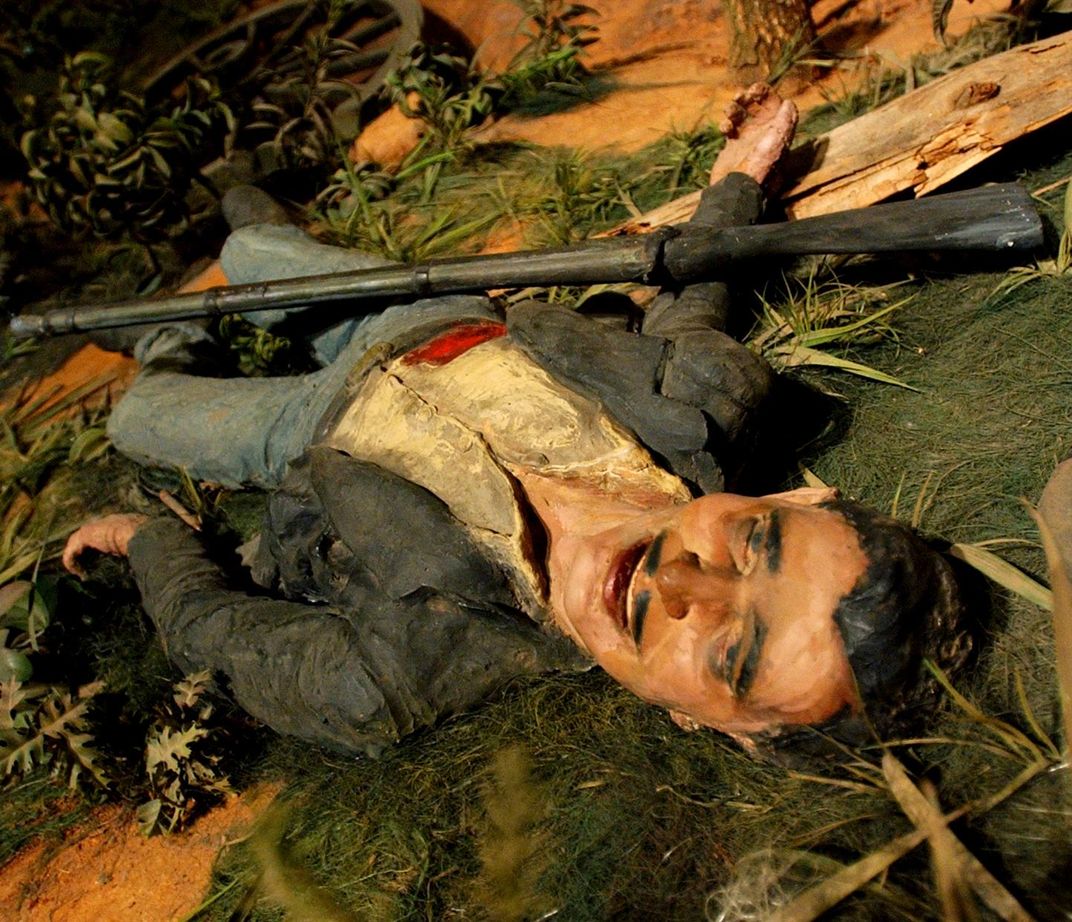
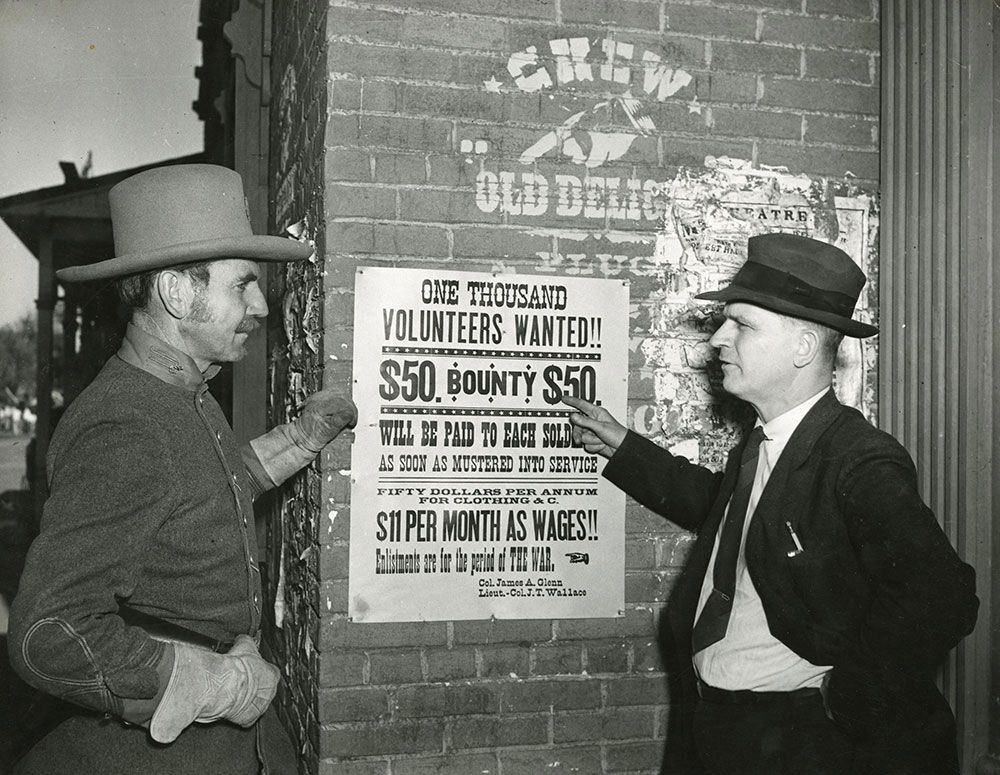
These direct plays to the audience may have worked for a while, but the appeal was short-lived. Interest in the war itself, the movements of troops, surges and countersurges, the Battle of Atlanta, had long ago become the province of Civil War aficionados, those guys who buy all the new Civil War books and schedule their social lives around the next re-enactment. But the general public was more interested in the zoo.
Then, a funny thing happened on the way to the future: the Voting Rights Act. By the early 1970s, certain city council members were pushing to have the Battle of Atlanta, properly understood as a Confederate victory, taken to Stone Mountain to become part of a neo-Confederate relic jamboree that is hosted up there. But by then, the mayor of Atlanta was Maynard Jackson, the first African-American to hold that office, and he had an “Emperor Has No Clothes” moment. Amid new legislation to relocate the canvas, he simply looked at the painting, saw what it was, and said so out loud.
“The Cyclorama depicts the Battle of Atlanta, a battle that the right side won,” he explained in 1979, “a battle that helped free my ancestors.” Jackson added, “I’ll make sure that that depiction is saved.”
In the last year or so since the neo-Confederate violence in Charlottesville, Virgina, discussions around the country have centered on “recontextualizing” Confederate statues and memorials. One can easily argue that Maynard Jackson was the first politician to make this case because, with his intervention, the Cyclorama was saved, this time with a new script for the sound system, voiced by James Earl Jones.
* * *
By 2011, though, the Cyclorama was again in shabby condition, a moth-eaten relic that a new mayor wanted to trash. “He put it on his list of city-owned assets that he viewed as white elephants,” said Sheffield Hale, who chaired the committee to decide how to dispose of things like the Cyclorama.
Downtown was now host to all kinds of buzzy attractions invoking the New Atlanta—the College Football Hall of Fame, the World of Coca-Cola, the Center for Civil and Human Rights. There were recommendations to hang the old canvas near Underground Atlanta, the shopping district, or maybe finally put it in that storage bin, wait a few decades, and throw it away.
That story hit the Atlanta Constitution on a Sunday in 2013 and one of the city’s most successful real estate moguls, Lloyd Whitaker, was reading the paper just before heading off to church. In fact, his firm, Newleaf, is typically described as a real estate turnaround company, and in that sense he saw the Cyclorama as something different—an object that drew a line from the new-media dreams of those German painters to Mayor Jackson’s epiphany. “The Battle of Atlanta was the death knell of the Confederacy,” Whitaker told an Atlanta blogger. “We are going to be able to preserve that in the literal sense with the painting, and symbolically with how that led to the civil rights movement.”
Around that same time Hale took a job at the Atlanta History Center, located in the city’s affluent Buckhead district. Whitaker offered $10 million as a lead legacy, and an incentive to raise even more money. Hale recognized right away how a new context for a cheesy 1880 spectacle could be created. “This was not an attraction,” Gordon Jones, the History Center curator, told me, “this was an artifact.”
“We ended up raising $25 million more to construct the building, restore the painting and do the exhibits,” Hale said. “We had the ability to really deal with the history of the painting and the Lost Cause and all that is wrapped up in the irony of the painting—and turn it into a different object.”
Hale and Jones are restoring the painting according to the documentary history recorded by the German artists in 1886. They want to recapture the original optical effect as well, with attention to scale and lighting. But they are also filling back in elements snipped out, painted over or otherwise altered over the years. Those Confederate captives, reimagined as fleeing Unionists by Atkinson, will again be shown as prisoners. And another image added by Atkinson, that of a Union flag ground into the mud, will be expunged.
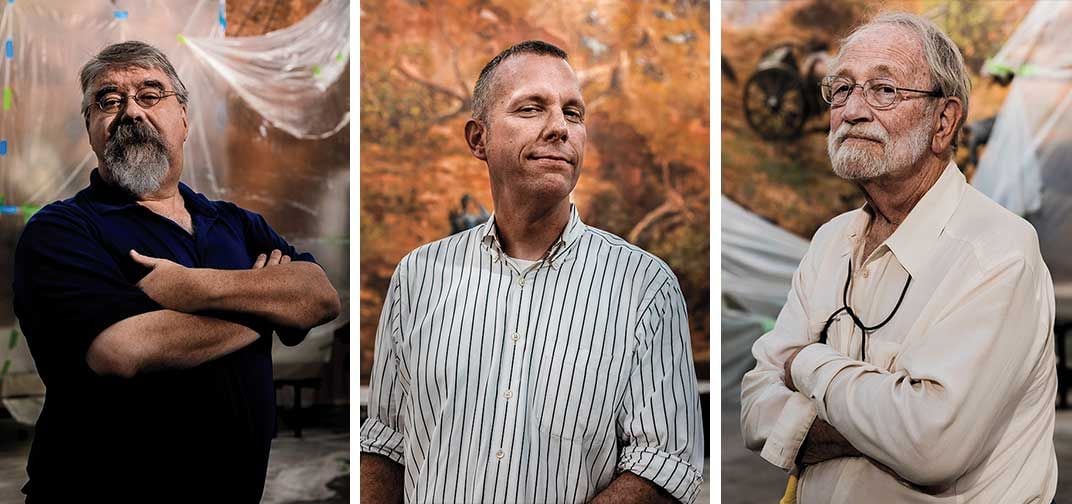
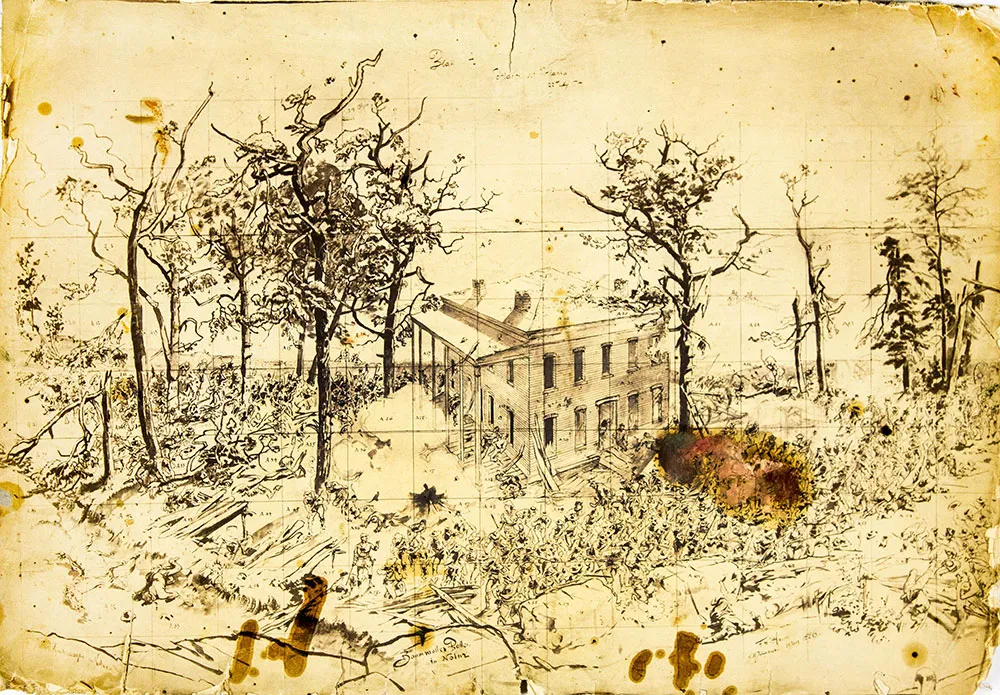
The story of those changing nuances in oil is presented as a narrative in two mediums. From the observation stage, a late 19th-century visual spectacle, restored to its full impact, offers an immersive experience of a pivotal battle. Down below, beneath the viewing level, extensive wall text lays out a detailed account of how the painting was revised to reflect mutable interpretations of the past.
Even the story of how the History Center moved the painting from its previous location signaled its new status as a highly symbolic relic. Strips of stabilizing canvas were adhered to the back of the 42-foot-high deteriorating canvas. In order to extract it from the domed building at the zoo, the painting had to be cut in half and rolled into two separate vertical pillars. A crane lifted each pillar straight out of a seven-foot-diameter hole cut into the rotunda—a Brobdingnagian illuminated manuscript revealing the changing history of Southern identity.
Once the painting had been transported and unfurled, restorationists could begin their work. Fittingly, the winning bid went to a firm from Germany—Weilhammer & Schoeller.
Uli Weilhammer showed me around the hall where a half-dozen artists, standing in pulley-suspended lifts, applied their skills. “You can’t put this painting on a table and work on it,” he said. He pointed out a depiction of a seemingly misshapen soldier at the bottom of the canvas and then walked up the stairs to the viewing platform. “As a conservator, you have to adjust for the distance,” he said. “You are painting on curved canvas.” He gestured below. “Look at some of these figures, close up they are quite distorted, they work only from here, from this perspective.”
Weilhammer indicated where that 56-inch-wide chunk of painting had been sliced out of the canvas a century ago. The section will be replaced, the painted sequence based on photographs of the original. Seven feet of new canvas, showing painstakingly recreated blue sky, has been added to return the panorama to its original dimensions. A high receding skyline is crucial to make the slightly bowed foreground feel like a three-dimensional landscape.
This new, reconceived Cyclorama is a monumental pageant that took a slow-motion flash mob of painters, politicians, promoters, propagandists and restorationists 140 years to complete—a multilayered artifact that tells the episodic tale of the Old South’s evolution.
It now measures 371.2 feet long and 49 feet high and weighs 9,400 pounds—no exaggeration.
Editor's Note, February 28, 2019: An earlier version of this story misstated the occupation of Wilbur Kurtz’s father-in-law. He was not officially a Confederate officer, but worked with the Confederacy during the Civil War.
/https://tf-cmsv2-smithsonianmag-media.s3.amazonaws.com/filer/99/de/99de3bf3-a4d3-4bd6-97e7-fee01fe14277/dec2018_f09_atlantacyclorama.jpg)

